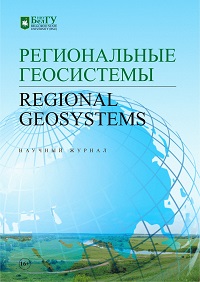The role of oil production in the acceleration of soil erosion in the steppe agricultural landscapes
The study was supported by RFBR grant No.20-05-00122А (No.АААА-А20- 120011390069-6) and under the theme of state assignment of IS UrB RAS No.АААА-А17-117012610022- 5 (Goszadanie).
DOI:
https://doi.org/10.18413/2712-7443-2020-44-3-283-294Keywords:
steppe zone, agricultural landscapes, oil production, soil erosion, intensification of gully formation, Volga-Ural regionAbstract
Against the background of prerequisites for the emergence of a global shortage of food resources, the most important task is a comprehensive assessment of the interaction of agricultural production and parallel industrial activities, such as oil and gas production. Among the main factors of technogenic destabilization of landscapes, which can contribute to the loss of productive agricultural land, can be identified soil erosion. The purpose of the study was to analyze the contribution of oil production to the development of erosion processes in mainly agricultural landscapes of the Volga-Ural steppe region. The
analysis of the development of the erosion network was performed at three key plots using Landsat satellite images. Digitization, mapping and classification of erosion network objects were performed for three time sections-1985, 2000, 2019. According to morphometric features, elements of the erosion network are classified into two classes: gullies and hollows. The activity of erosion processes was estimated by zoning based on the density of spatial distribution of elements of the erosion network. It was found that the catalyst for the intensification of soil erosion is the functioning of oil fields, mainly at the stage of maximum technogenic load – during this period, the total length of the erosion network elements can increase by more than 4 times. Agricultural land located in the zone of influence of the oil field is subject to an increased risk of development of new and activation of existing elements of the erosion network – the activity of gully formation can increase by more than 20 %.
Downloads
References
Аввакумова А.О. 2020. Математическое моделирование факторов эрозии почв на пахотных землях (на примере территории Республики Татарстан). Региональные геосистемы, 44 (1): 5–15.
Борисюк Н.К. 2009. Нефть и экономика. М: Экономика, 340 с.
Григорьев И.И., Рысин И.И. 2006. Исследования техногенных и сельскохозяйственных оврагов в Удмуртии. Вестник Удмуртского университета. Серия Биология. Науки о Земле, 11: 83–92.
Ермолаев О.П., Медведева Р.А., Платончева Е.В. 2017. Методические подходы к мониторингу процессов эрозии на сельскохозяйственных землях европейской части России с помощью материалов космических съемок. Ученые записки Казанского Университета. Серия Естественные науки, 159 (4): 668–680.
Ермолаев О.П., Рысин И.И., Голосов В.Н. 2016. Картографирование овражной эрозии в регионе востока Русской равнины. Геоморфология, 2: 38–51.
Зорина Е.Ф. 2003. Овражная эрозия: закономерности и потенциал развития. М., ГЕОС, 170 c.
Леонтьев O.K., Рычагов Г.И. 1979. Общая геоморфология: учеб. пособие для географ. специальностей вузов. М., Высшая школа, 287 c.
Муллаев Б.Т., Саенко А.Е. 2019. Первоистоки Мангышлакской нефти. Месторождение Жетыбай. Киев, Strelbytskyy Multimedia Publishing, 471 c.
Хорошев А.В. 2016. Полимасштабная организация географического ландшафта. М., ООО ТНИ КМК, 416 c.
Чибилёв А.А. 1992. Экологическая оптимизация степных ландшафтов. Свердловск, УрО АН СССР, 164 c.
Ahmed Z. 2015. Determination and Analysis of Desertification Process with Satellite Data Alsat-1 and Landsat in the Algerian Steppe. Engineering Geology for Society and Territory. Springer International Publishing, 2: 1847–1852.
Arabameri A., Pradhan B., Bui D.T. 2020. Spatial modelling of gully erosion in the Ardib River Watershed using three statistical-based techniques. Catena, 190: 104545.
Bartalev S.A., Plotnikov D.E., Loupian E.A. 2016 Mapping of arable land in Russia using multiyear time series of MODIS data and the LAGMA classification technique. Remote Sensing Letters, 7 (3): 269–278.
Baynard C.W., Mjachina K., Richardson R.D., Schupp R.W., Lambert J.D., Chibilyev A.A. 2017. Energy Development in Colorado’s Pawnee National Grasslands: Mapping and Measuring the Disturbance Footprint of Renewables and Non-Renewables. Environmental Management, 59 (6): 995–1016.
Dotterweich M., Stankoviansky M., Minár J., Koco Š., Papčo P. 2013. Human induced soil erosion and gully system development in the Late Holocene and future perspectives on landscape evolution: The Myjava Hill Land, Slovakia. Geomorphology, 201: 227–245.
Jones N.F., Pejchar L. 2013. Comparing the Ecol. Impacts of Wind and Oil & Gas Development: A Landscape Scale Assessment. PLOS one, 8 (11): e81391.
McClung M. R., Moran M. D. 2018. Understanding and mitigating impacts of unconventional oil and gas development on land-use and ecosystem services in the US. Current Opinion in Environmental Science & Health, 3: 19–26.
Trabucchi M., Comín F.A., O’Farrell P.J. 2013. Hierarchical priority setting for restoration in a watershed in NE Spain, based on assessments of soil erosion and ecosystem services. Regional Environmental Change, 13 (4): 911–926.
Wang G., Innes J., Yusheng Y., Shanmu C., Krzyzanowski J., Jingsheng X., Wenlian L. 2012. Extent of soil erosion and surface runoff associated with large-scale infrastructure development in Fujian Province, China. Catena, 89 (1): 22–30.
Abstract views: 204
Share
Published
How to Cite
Issue
Section
Copyright (c) 2020 REGIONAL GEOSYSTEMS

This work is licensed under a Creative Commons Attribution 4.0 International License.


